British people are eminently sensible (or at least they are in some things, but obviously not when it comes to Brexit or voting Tory, but let’s not dwell upon that) and as such many of them will have owned an Atari computer at some point during the 80s. However it’s likely to have been one of the 16-bit ST series of machines from the Tramiel era, and very nice those machines were too (I was way more of an ST man than an Amiga dude myself back at that point in history).
Not so many people are familiar with Atari’s 8-bit machines though, because just by dint of timing, pricing and how things unfolded during 8-bit times on our lovely isle of tea and biscuits the A8 machines (for that is how we refer to them historically now that we all live in the future) sort of fell through a gap in the market and were never really that popular here.
These machines were actually rather special though, and there was some excellent software developed for them, which it’d be a particular shame for you to have to go through an entire lifetime never having seen. Plus it’s getting on for winter which is an excellent time for weekend emulator fiddling and game playing so I thought it might be nice to do a little intro to the Atari 8-bits, link to a decent setup that you can download and use to explore some of their library yourself, and an ongoing series of occasional posts looking at some of the games.
If you remember the A8s at all you probably remember the XL (and later the XE) series machines that only really appeared in Britain as those other machines you’d sometimes see in the shops that nobody bought many of because they weren’t Commodore 64s or Spectrums. And whereas you wouldn’t look as much of a pillock to your mates if you’d bought one as you would if you’d've bought an Oric or a Camputers Lynx or something daft like that you probably would have still felt like a second class citizen compared to your mates with their Speccys and C64s.
However it wasn’t always like that. There was a period in the early 80s when the Atari 8-bit machines seemed glamorous and alluring and were the object of desire for a certain class of computer spods, myself included. To understand this you have to understand certain conditions that prevailed at the time.
Firstly, we fucking loved Atari. It’s hard to imagine how loved Atari was back then, especially in this day and age; but for a bunch of us growing up round then Atari were synonymous with videogames, both in the arcade and at home. The Atari VCS looks laughably primitive to us now but back then it was the most amazing thing, bringing an ever-growing selection of brightly-coloured and playable games to your telly, beating the crap of the boring Pong-based machines that had come before it. The name “Atari” became synonymous with the act of gaming itself and kids would say they were coming round to “play Atari” (as would similarly happen with the name “Nintendo” some years later). Plus they made or licensed some of the best coin-ops in the arcade, so if you were a gamer at the start of the 80s, you by default loved Atari.
Secondly the machines were incredibly advanced for their time. The basic design of the machines was begun in 1978, originally intended to be a more advanced game console that developed and extended a lot of the ideas that had gone into the VCS. Around that time home computers such as the PET, TRS-80 and Apple ][ started to become popular and the extended-VCS design was itself extended to incorporate the features of a proper home computer. Home computers of that era were in general rather janky and unattractive from a game enthusiast's point of view, usually featuring monochrome displays, a complete lack of sound, and bugger all in the way of controllers. The Apple ][ fared a little bit better in that it had a bitmapped colour display, farty Spectrum-level sound and the possibility of plugging in those floppy analogue controllers that nobody ever used for proper gaming back then. The Apple ][ never gained a toehold amongst gamers in the UK however, largely because it cost about as much as the moon and was pretty useless without a disk drive, which was another lunar-magnitude expense on its own.
And so it was for us in 1980. The spoddiest of us computer spods had obtained the likes of the ZX80 and the Acorn Atom and were rasterbating furiously over those machines, or farting about on the PETs and TRS-80s at school or college. We'd heard of the Apple ][ but in all likelihood never actually seen one in the flesh. Then in October 1980, nearly a year after their launch in the US, Personal Computer World brought us news of new machines, made by our sainted and beloved Atari, and destined for the UK.
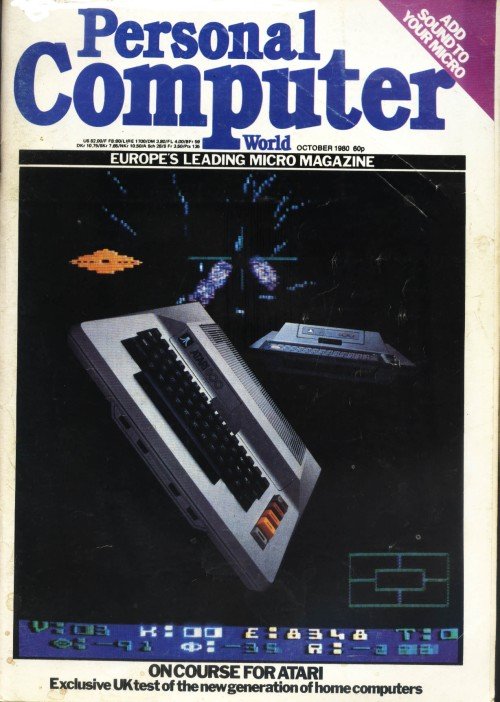
An 8-bit porn mag.
I still remember having that magazine in my digs at uni, I must have read the bit about the Atari machines hundreds of times, poring over every detail like a beloved porno. Compared to what we were used to, from an aspiring game designer's point of view these new machines were nothing short of incredible, full of all kinds of features to make the very tasks we struggled to achieve in games programming on existing machines both massively easier and hugely less limited. Reading again and again the details about such things as hardware scrolling, player/missile graphics, display lists, amazing colour capabilities and compatibility with existing Atari controllers was enough to make one's own joystick somewhat tumescent.
The machines were available in two flavours, the somewhat space-age-looking Atari 400:
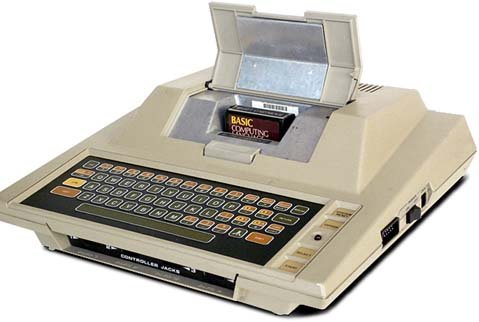
Atari 400. Beam me up Scotty.
with its Star Trekian angularity and jizz-proof keyboard (which was perhaps less of a deterrent than it ought to have been for those of us already inured to the ZX80's plastic membrane which had a keyfeel about the same as drumming your fingers on the desk). Here you can see the cartridge lid flipped open and the BASIC cartridge inside - not that that would be staying in there for any length of time for those of us who did end up getting one of the machines, but we'll get to that later. It even boasted an incredible FOUR joystick ports along the front of the machine, a generosity and ergonomic bounty of interface possibilities that would not be equalled for many years to come.
The big brother to the 400 was the somewhat more conventional-looking 800, which looked rather like some kind of office typewriter:
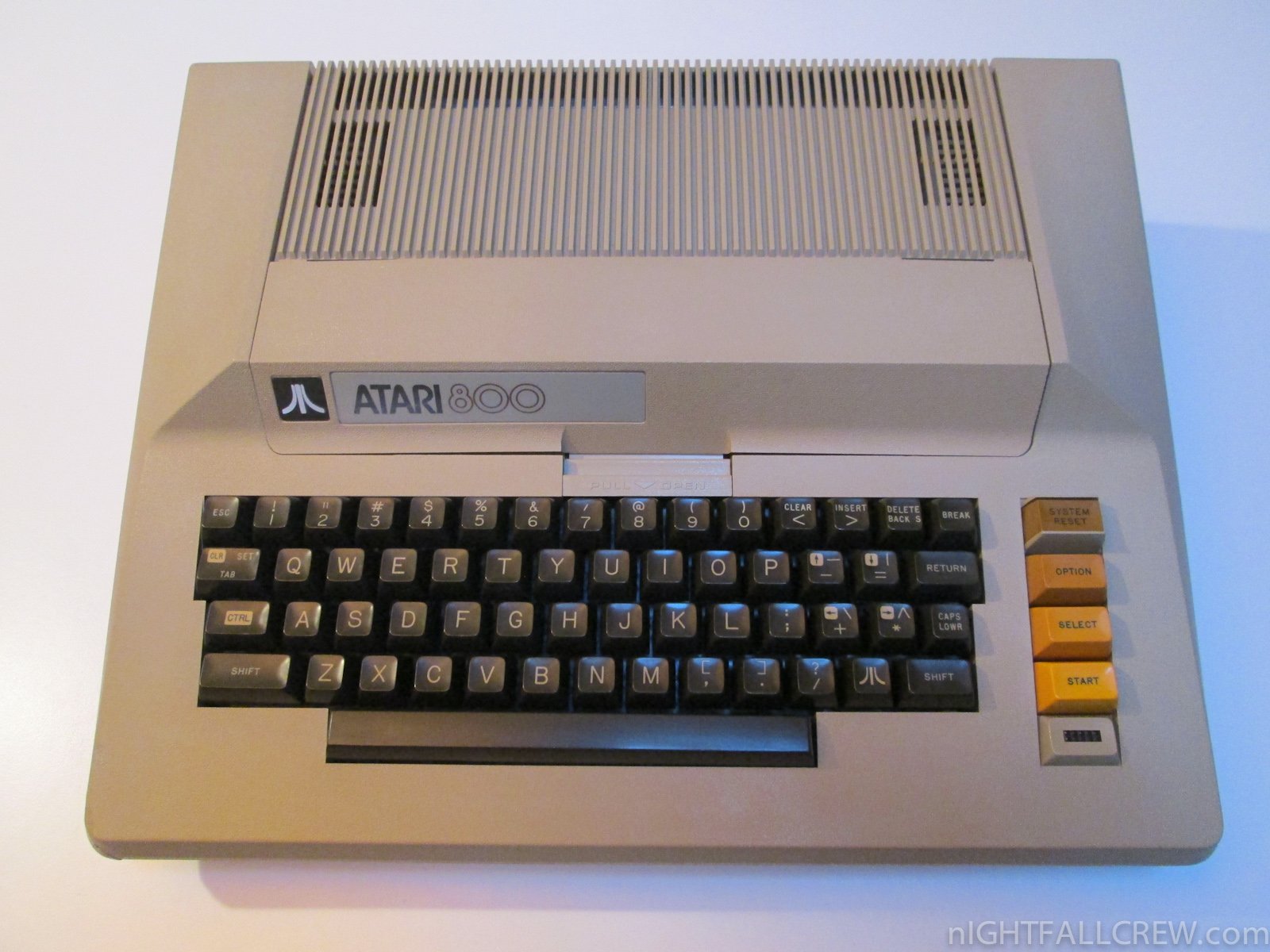
The imposing Atari 800.
and I am sure Atari probably had hopes of making inroads into the business market, but let's face it business types were more likely to go for the existing TRS-80, PET or an Apple ][ if they really wanted to be posh. The 800 had the distinction of being built like an absolute tank, and boasted 16k (later 48k) of RAM and an extra cartridge slot that nobody ever used.
Best of all was the potential for excellent gaming software on these machines. Atari owned the rights to a lot of the most popular arcade games by dint of either having already made or licensed the games themselves, and with all that fancy hardware there was the possibility of hods of excellent games making their way onto those machines. There was also Star Raiders, a game that for its time was so gob-smackingly amazing that anyone who saw the game in action (or even read about it in the stuck-together pages of that PCW magazine) was immediately inseminated with a burning desire to possess a machine to run it on.
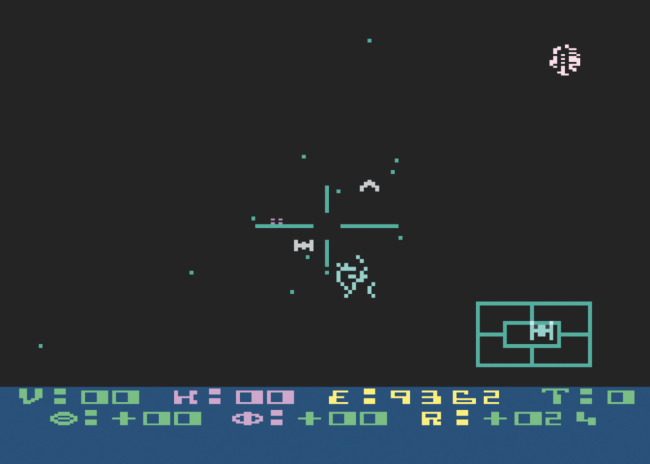
Star Raiders. Spooooooge.
My favourite arcade game of the time was Exidy "Star Fire" which featured the same first-person out of the cockpit window view. Star Raiders promised not only to bring that experience home but also enhanced it by bolting on features that until then had been purely the domain of the ultra-spoddy text-based Star Trek games that proliferated on the less capable machines to yield an arcade/strategy game hybrid that concealed an astonishing depth of gameplay in its meagre 8K of 6502 machine code.
A particularly outstanding feature of the Atari machines was the mind-blowing wealth of colour they allowed programmers to bring to bear on their game creations. Many machines of that era were pedestrianly monochrome; if you had colour at all it was a huge deal, and just about every other machine could only muster up eight, or if you were lucky 16 colours in total. The Atari smashed that limit utterly and allowed programmers to have exotic luxury like several shades of blue on one screen.
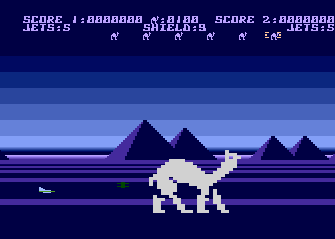
Several shades of blue I tell you.
With capabilities like these, a fistful of great software licenses in hand, and the undying love of every potential new game programmer in the country, surely then Atari with these machines would sweep forth and take over Britain? Alas, it was not to be.
The trouble being basically that upon introduction the machines were priced roughly in line with their model numbers. Ouch. In Eighties quids as well. Us British computer spods were an impecunious lot, and so excellent though these machines promised to be they were admired from afar as being akin to the Apple ]['s sexier siblings rather than anything we could actually be hoping to buy. And by that time Uncle Clive was cranking up to the peak of his career and bringing us first the ZX80 (at under a ton the first machine I could ever actually afford to buy), then the ZX81 (miraculously both better than the ZX80 and considerably cheaper) and ultimately the Speccy (crowning glory of Uncle Clive's career and the direct genesis of the UK game development scene). Commodore brought out the VIC-20, also cheap as chips and with a decent keyboard, appealing to those of us who'd cut their teeth on 6502-based systems like the PET. So us nerds hoovered up these less capable but a hell of a lot cheaper systems while the Ataris languished out there on the exotic boundary.
Of course this situation didn't last, Commodore firing the first broadside across the industry in what proved to be a punishing price war that decimated the early home computer scene, and also introducing the Commodore 64 which everyone agreed was just the best computer ever, even those who had bought Spectrums, although they would never allow themselves to admit it and they carried that self-delusion with them throughout their entire lives, scarring them to this very day. Atari too became embroiled in the price war, and the prices of the hitherto exotic A8 systems tumbled - but by then everyone was already decided for either the C64 or the Speccy and the machines were never taken up in significant numbers, leaving Atari very much the Green Party to Uncle Clive and Jack Tramiel's Tories and Labour.
For some of us though the Atari machines still had about them a bit of glamour and arcade allure that the other machines, even great ones like the Commodore 64, somehow lacked. The possibility of great, cartridge-based arcade ports was enticing. I was fortunate enough to get my first Atari machine during the Vic-20 era, when they were still quite expensive and finding anywhere selling them and the software for them was pretty rare. I only knew a couple of fellow Atari owners in my area, and we'd meet up several times a month for gaming sessions and yes, a bit of yo-ho-ho did go on, as it always did back then, but in the case of the Atari it was as often as not simply because a lot of the games were hard to come by via legitimate means unless you were prepared to order stuff from the US. Atari of course were turning out their arcade ports, and there was a succession of other good games coming mostly out of the US, where people were richer and the Ataris had caught on more than they had here. Much of this software was well-made and had quite a different "flavour" to the British and European stuff we saw a lot of on our 64s and Speccies. Us Atarians felt like we had access to games that were somehow more exotic, more arcadey-feeling somehow, than those available on our other machines.
A8 software, the best of it, has a special kind of feeling, I don't know how to explain it really, except that it feels more "arcadey". That isn't to say that it was all brilliant - there was a fair share of smeg as there was on all machines, and not even Atari themselves were consistently excellent, as we shall come to see. But there was some truly excellent stuff on there, and some games that people might know better on other machines originally had their start (and often their best implementation) on the Ataris. I still enjoy wandering through the A8 section of my emulator collection (or even occasionally firing up my original 800 that I still have, and which still works fine apart from the space bar, which I broke back in the day doing Smart Bombs with my foot whilst playing Defender).
I thought it might be fun to do a series of blog posts about some of these games, especially as a lot of British people might have missed them entirely, having never owned an A8-series machine. If you're interested, it's also pretty easy for you to follow along with me, or wander through some of the A8 library on your own, through an extensive curated collection of "the best of Atari 8-bit" which you can download from this page here. This collection contains over a thousand games and the emulators necessary to run them, all contained in a neat UI and accompanied by extras such as manuals and screenshots and is a complete piece of piss to install.
Right that’s it for the intro. Next posts I’ll get on to the games. If you don’t know 8-bit Atari that well do make yourself a cup of tea, grab some biscuits and join in, there’s some great stuff to be found!











